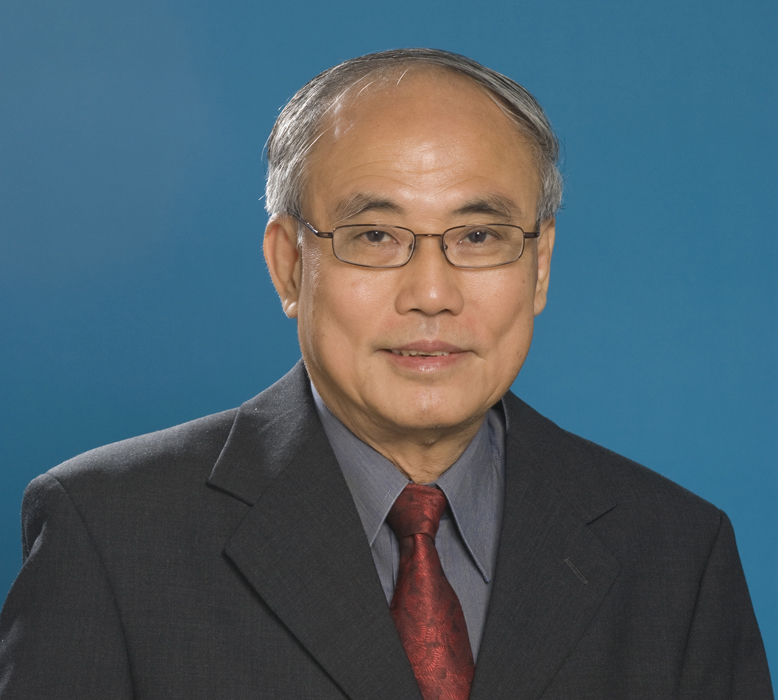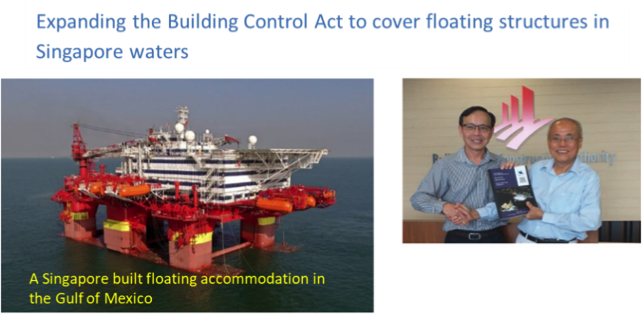President's Message
Message 30/2019

Mr Lim Soon Heng, PE, FIMarEST.
Founder President
Expanding the Building Control Act to cover the floating structures in Singapore waters

Is a floating structure in Singapore waters a building or a ship? Is it subject to statutes of the Building Control Authority (BCA) or the Maritime and Port Authority (MPA)?
The law deems it a building. The Building Control Act applies. Specifically, the Act defines a “building” to include
“a floating structure, not being a boat or vessel, constructed or to be constructed on a flotation system that —
(i) | is or is to be supported by water; | ||
(ii) | is not intended for or useable in navigation; and | ||
(iii) | is or is to be permanently moored;” | ||
The Building Control Regulations 2003 however, as it stands, does not deal with floating structures adequately. This is understandable. The application of floating structures as alternative to structures on land is a new engineering innovation not only in Singapore but worldwide. I am not aware any jurisdiction in the world where regulators address issues relating to floating structures.
The engineering fundamentals of floating structures such as intact and damaged stability, the effects of waves on the floating platform, rigid and flexible floating bodies, mooring systems, tidal changes, bending stresses due to waves, connections between floating modules, metacentric height, or righting moments (GZ curve) are not embodied in any building codes here or elsewhere.
Singapore is fortunate that we have a pool of talents that over the past 50 years have delivered floating structures to all corners of the world. We are of the view that BCA would do well to consider tapping their expertise to draft design guidelines for floating structures.
Singapore has as much experience in designing and building offshore structures as anywhere in the world. Apart from in-house expertise in the large shipyards, there exists many independent consulting firms. Additionally, the world’s leading classification societies, such as DNV-GL, Lloyds Register, ABS (American Bureau of Shipping) are present in Singapore. They too could be useful in the drafting process.
However I hasten to add, we should not put the use of floating structures on hold just because the building regulations is just now inadequate to address their design and engineering, just as in the 1980’s we did not prevent the construction of underground tunnels for the MRT even if the Act was inadequate to address their design and engineering.
There are two key professionals under the Building Control Act. These are the Qualified Person (QP) and the Accredited Checker (AC). Their responsibilities are defined in the Act.
Briefly, “A Qualified Person is a person who is registered as an Architect with the Board of Architects (BOA) or a Professional Engineer with the Professional Engineers Board (PEB); and has a valid practising certificate issued by the BOA or PEB, respectively.
The Accredited Checker is a QP whose role is to “ (a) evaluate, analyse and review the structural design in the plans of any building works and (b) verify that the key structural elements designed are consistent with the layout shown in the architectural plans and any amendment thereto.”
There are 1344 civil engineer registered with the PEB (The Professional Engineers Board) but only one registered Naval Architect and one Marine Engineer. Opening the PEB registry of Qualified Persons to include many more naval architects and marine engineers is a necessary step if the procedures for design checks for floating structures are to be in alignment with the practice for landed structures.
The Society can play a role to assist PEB on drafting the requirements for the registration of QPs and ACs for floating structures to comply with the Act and to serve as a body with the necessary skills to adjudicate candidates professional experience and education for qualification.
In a meeting on November 5, with Mr Chew Keat Chuan, Group Director, Building Engineering Group and his colleague Er. Dr Tran Chi Trung, Deputy Director of the Building and Construction Authority my colleague Dr Koh, Vice President and I, discussed these issues. It is refreshing to observe the receptive attitude and support that these gentlemen showed for floating structures.
Mr Chew also foresaw that floating structures go beyond solving Singapore’s space constraints. He felt, as we do, that it could be another contributor to Singapore’s foreign exchange earnings. Floating hotels, homes and even recreation parks are mobile assets and hence exportable not unlike rigs and ships. Being a global leader in the construction of oil and gas rigs, FPSOs, FSRUs it is not difficult to achieve this.
Floating solutions should be allowed in Singapore waters even as drafting regulations is still work in progress. Floating structures can be regularised retrospectively by the authorities on condition they are certified to have complied with the rules of one of the several international classification societies (e.g. ABS, LR or DNG-GL) and would be insurable by marine underwriters.
This parallel approach of drafting regulations while concurrently issuing permits for floating structures is more realistic than to draft rules and regulations without the benefit of ongoing field experience. Indeed, field experience is necessary for the drafting of robust, practical and meaningful regulations.
A preliminary master plan can be put in place to prevent a hotchpotch development in the sea. The preliminary plan is dynamic and can be adjusted with minimal disruption to owners. Entire clusters of floating structures may be reoriented or moved with ease. Even highway bridges, if necessary, may be moved and repositioned with ease if it stood in the way of new plans; not that there would be many in floating developments as current modes of wheel-based transport would no longer the only way to commute.
Authorities may impose certain conditions that the developers agree to relocate floating structures, within a specified time frame if needed. If developers agree, there is no planning reason to deny them mooring permits. For example, a floating hotel moored south of Marina Barrage may, after a several years if required by urban planners for planning reasons, be relocated to the Greater Southern Waterfront. This offers a degree of flexibility in planning not possible with city planning for onshore structures.
President
Lim Soon Heng
12 November 2019
